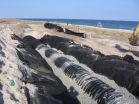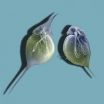(Press-News.org) The phenomenon of adoption has taxed the minds of evolutionary scientists since Darwin first came up with his account of natural selection. According to Richard Dawkins's description, adoption is "a double whammy. Not only do you reduce, or at least fail to increase, your own reproductive success, but you improve someone else's." So why are animals apparently so willing to take care of young that are not related to them?
Franziska Schaedelin and colleagues at the Konrad Lorenz Institute of the University of Veterinary Medicine, Vienna now shed interesting light on the problem. The researchers are investigating a small cichlid fish that lives in Lake Tanganyika in southern Africa. The species is monogamous and pairs construct nesting caves to protect their eggs and fry from predators. By diving 12 meters to the lake floor, the scientists were able to collect DNA samples from over 350 parents and fry from over 30 nests. Sophisticated genetic techniques were then applied to investigate the parentage of fry in individual nests.
Most nests were found to contain fry that were unrelated to both "parents", with some nests containing fry produced by several pairs of parents. Because the locations of the nests were known, the scientists were able to show that fry had been born in nests that were separated by less than one metre to over 40 metres from their adoptive nests. Although very small fry may be able to swim several metres to a new cave without being eaten, it is highly unlikely that they could travel much longer distances. Instead it is probable that they were carried to new nests in the mouths of their parents, a mode of transport that is known to occur in cichlids. Transporting the fry to fairly distant nests would ensure that some young are protected even if all the nests in the immediate neighbourhood are predated or destroyed, so it is easy to rationalize why parents should do this. But why should other fish be willing to adopt fry that are unrelated to them?
Schaedelin suggests that foster parents may accept unrelated fry as a way of diluting predation of their own offspring. If this is so, parents should adopt fry that are not larger than their own young, as smaller fry are known to be predated first. The researchers were indeed able to show that adopted fry were the same size as native fry within broods, although they were generally larger than fry that were not offered out for adoption. It seems that parents selectively allow unrelated fry to assimilate into their own broods while also delivering their fry for adoption by others.
Sharing the care of broods among different families thus represents a kind of insurance policy against the predation of a nest. Schaedelin summarizes the findings neatly: "in a species that is so highly predated, it must have been important to develop a strategy to ensure that at least some of the young survive. It seems that fish do this by not putting all their eggs (or young) in one basket."
###
The paper "Nonrandom brood mixing suggests adoption in a colonial cichlid" by Franziska C. Schaedelin, Wouter F.D. van Dongen and Richard H. Wagner is published in the current issue of the journal "Behavioral Ecology" (2013, 24(2):540-546). The abstract of the original paper is available online at http://dx.doi.org/10.1093/beheco/ars195 (full text for a fee or with a subscription).
About the University of Veterinary Medicine, Vienna
The University of Veterinary Medicine, Vienna is the only academic and research institution in Austria that focuses on the veterinary sciences. About 1000 employees and 2300 students work on the campus in the north of Vienna, which also houses the animal hospital and various spin-off-companies.
http://www.vetmeduni.ac.at
Contact
Dr Richard Wagner
Konrad Lorenz Institute of Ethology
University of Veterinary Medicine, Vienna
T +43 1 489 0915-831
E richard.wagner@vetmeduni.ac.at
Dr Franziska Schaedelin
Konrad Lorenz Institute of Ethology
University of Veterinary Medicine, Vienna
T +43 1 489 0915-849
E franziska.schaedelin@vetmeduni.ac.at
Dr. Wouter van Dongen
Konrad Lorenz Institute of Ethology
University of Veterinary Medicine, Vienna
T +43 1 489 0915-838
E wouter.vandongen@vetmeduni.ac.at
Klaus Wassermann
Public Relations/Science Communications
University of Veterinary Medicine, Vienna
T +43 1 25077-1153
E klaus.wassermann@vetmeduni.ac.at END
Risk management in fish: How cichlids prevent their young from being eaten
2013-03-19
ELSE PRESS RELEASES FROM THIS DATE:
Genetic testing may be used to identify BPH patients with increased risk of prostate cancer
2013-03-19
Milan, 19 March 2013 – Patients with benign prostatic hyperplasia (BPH) carrying prostate cancer (PCa) a risk alleles are a potential target population for PCa screening and follow-up, according to a study, which was presented yesterday at the 28th Annual EAU Congress in Milan.
The study aimed to evaluate the genetic predisposition of patients with BPH to developing prostate cancer, with findings suggesting that genetic testing may offer a new tool to identify BPH patients with increased risk to develop PrCa.
"To our knowledge this is the first study to evaluate genetic ...
Study points to risk factors of mesh-related complications in prolapse surgery patients
2013-03-19
This retrospective multicenter study, which included 677 patients from 6 centres, aimed to evaluate intraoperative, early postoperative and mesh-related complications for surgical management of female pelvic organ prolapse (POP) with application of trocar guided transvaginal synthetic mesh.
In the course of the study the patients underwent POP surgery from 2006 to 2010. The patients were operated for symptomatic genital prolapse POP-Q stage 2 to 4. Patients were systematically seen within 1 and 3 months and then evaluated again during the study via phone interview and ...
Most men with erectile dysfunction remain untreated, say US scientists
2013-03-19
Milan, 19 March 2013 - Despite the high erectile dysfunction (ED) prevalence most patients receive no treatment, according to a new US study, presented at the 28th Annual EAU Congress. Undertreatment of ED continues to be common, even though the treatments have a proven efficacy and quality of life impact.
"Until now, research conducted on the treatment of erectile dysfunction has been derived from surveys involving small populations," wrote the authors.
"However, a comprehensive and larger patient-based study using claims data that characterises men undergoing treatment ...
New clues in hunt for heredity in type 2 diabetes
2013-03-19
Type 2 diabetes has strong hereditary tendencies and the genes we are born with cannot be changed. However, new research from Lund University in Sweden shows that we can modify the function of the genes through the epigenetic changes that take place in the course of life.
Epigenetic changes are usually described as a link between heredity and environment and come about as a result of factors such as ageing, chemicals, medication, diet, exercise and drugs.
Researchers have now demonstrated that half of the known genetic risk variants for type 2 diabetes can be influenced ...
Cell Transplantation study finds stem cells in deer antler
2013-03-19
Putnam Valley, NY. (Mar. 19 2013) – A team of researchers in Seoul, Korea have reported finding evidence that deer antlers - unique in that they regenerate annually - contain multipotent stem cells that could be useful for tissue regeneration in veterinary medicine.
The study appears as an early e-publication for the journal Cell Transplantation, and is now freely available on-line at http://www.ingentaconnect.com/content/cog/ct/pre-prints/ct0897seo.
"We successfully isolated and characterized antler tissue-derived multipotent stem cells and confirmed that the isolated ...
Spanish researchers link cancer to failures in chromosome protection for the first time
2013-03-19
A study published today in the journal Nature Genetics explores a new mechanism that may contribute to the development of several tumours, including Chronic Lymphocytic Leukaemia, a type of cancer that affects more than a thousand new patients in Spain each year.
This work, led by researchers Carlos López-Otín, from the University Institute of Oncology at the University of Oviedo; Elías Campo, from the Hospital Clínic/University of Barcelona; and María Blasco, the Director of the Spanish National Cancer Research Centre (CNIO), represents a significant milestone for the ...
Researchers devise hidden dune filters to treat coastal stormwater runoff
2013-03-19
When it rains, untreated stormwater can sweep pollutants into coastal waters, potentially endangering public health. Now researchers from North Carolina State University have developed low-cost filtration systems that are concealed beneath sand dunes and filter out most of the bacteria that can lead to beach closures.
"It was not economically feasible to use a tract of beachfront property to treat stormwater. Instead, we were able to devise a system that could be installed in an area that was not developable – underneath the dunes," says Dr. Michael Burchell, an assistant ...
It's a sure thing: Knowledge of the game is not an advantage in sports gambling
2013-03-19
Psychologists have traditionally characterized compulsive gambling as an "impulse control disorder," and treated it by addressing the patient's obsessive tendencies. But according to Prof. Pinhas Dannon of Tel Aviv University's Sackler Faculty of Medicine and the Beer Yaakov Mental Health Center, not all pathological gamblers fit the same profile.
Though gambling is typically associated with casino games, strategic sports betting is rapidly gaining in popularity — and that's a whole other ball game, Prof. Dannon explains. "Sports gamblers seem to believes themselves the ...
Can a tropical water flea invade European lakes?
2013-03-19
Daphnia is a genus of small, planktonic crustaceans, commonly called 'water fleas' because of their jumpy swimming style and their size (between 0.2 and 5 mm). They live in various aquatic environments, ranging from acidic swamps to freshwater lakes, ponds, streams and rivers. Species of the genus Daphnia play a key role in freshwater food webs: they consume algae and are themselves an important food item for small fish.
Daphnia lumholtzi is a small subtropical and tropical representative, known as an invader in North America. It has never been found in Europe in the ...
Caterpillar-walk exhumation, the downfall of the Moche, and trilobites in camouflage
2013-03-19
Boulder, Colo., USA – New Geology articles posted online ahead of print cover everything from cratering on Mars to leopard-like camouflage in trilobites. Locations studied include the Ries Impact Crater; Hydrate Ridge, Oregon; Stromboli volcano; northern Peru; the Bushveld Complex, South Africa; western and central New York state; the Sahara Desert; and the French Alps. Brief highlights follow:
1. Analogous cratering at the Ries Impact Crater, Germany, and on Mars;
2. A presentation of the first secure, high-resolution land-sea PSV-based sediment-core synchronization;
3. ...

